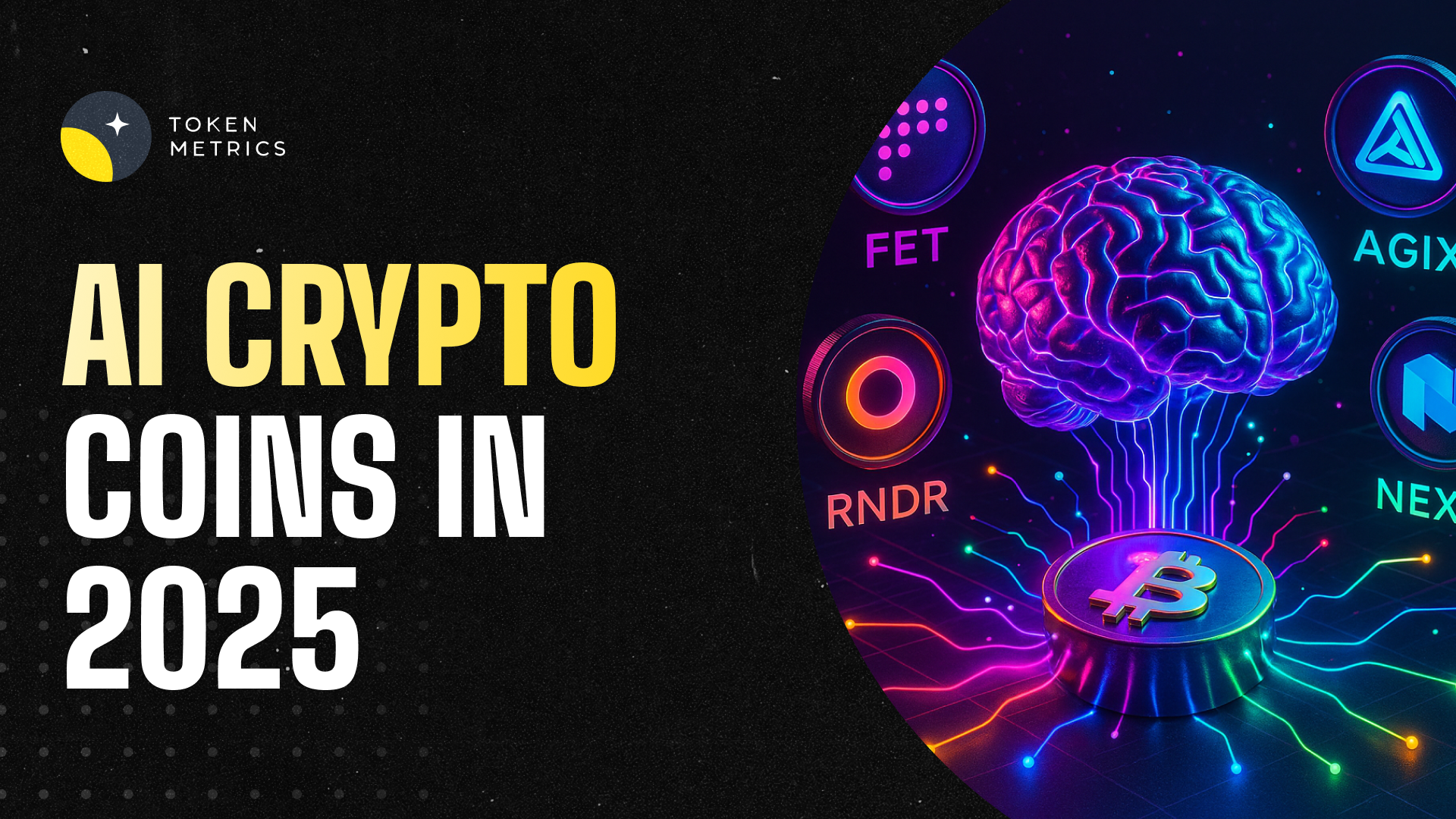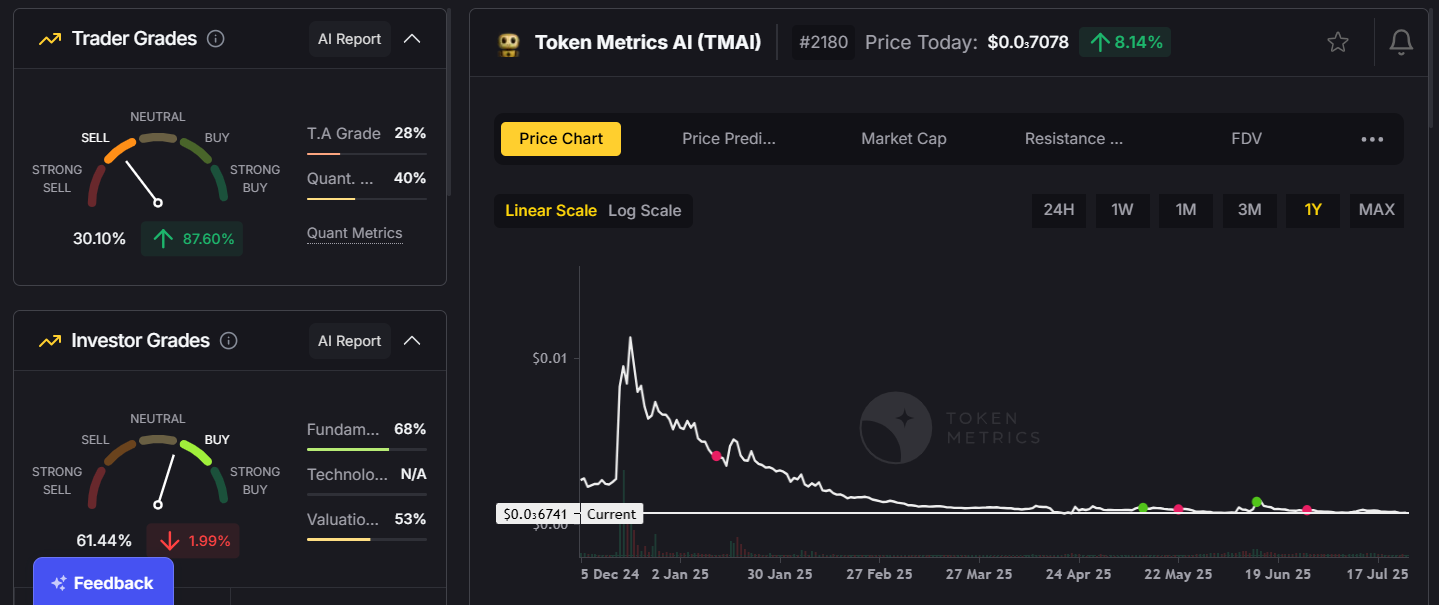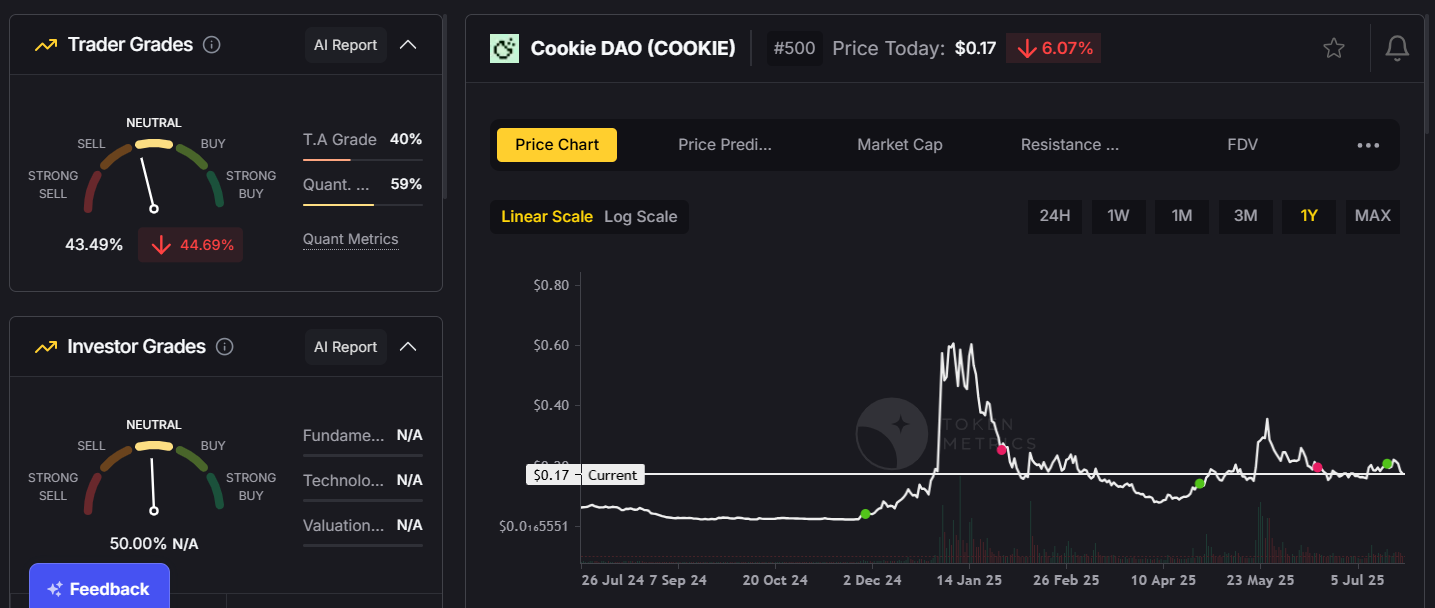AI Crypto Coins: Unlocking the Future of Blockchain and Artificial Intelligence in 2025

Introduction to AI Crypto Coins
Artificial intelligence (AI) has become one of the most transformative technologies of our time, reshaping industries from healthcare to finance. In the cryptocurrency space, AI crypto coins are merging blockchain with artificial intelligence, creating powerful ecosystems for data analytics, automated decision-making, decentralized AI marketplaces, and predictive trading.
In 2025, AI-powered tokens are one of the most promising sectors in crypto, attracting retail investors, institutional players, and developers seeking the next wave of technological breakthroughs. This article explores what AI crypto coins are, how they work, their benefits, key risks, and the role of Token Metrics in analyzing and investing in them.
What Are AI Crypto Coins?
AI crypto coins are digital tokens that fuel blockchain platforms integrated with artificial intelligence technologies. These coins serve multiple purposes, including:
- Powering AI-Driven Platforms: Providing access to AI tools and algorithms.
- Facilitating Machine Learning: Enabling decentralized model training and data processing.
- Enabling Predictive Analytics: Supporting platforms that use AI to forecast market trends.
- Fueling Autonomous Agents: Powering AI agents for decentralized applications (dApps).
By combining the transparency of blockchain with the intelligence of AI, these projects are creating self-sustaining ecosystems where users can buy, sell, and deploy AI services securely.
Top AI Crypto Coins in 2025
The AI crypto sector is diverse, with projects addressing various use cases. Here are some of the leading tokens:
One of the most innovative AI-driven analytics platforms in crypto. TMAI leverages over 80 data points per token, offering AI-generated ratings, trend analysis, and portfolio insights to help traders and investors make data-driven decisions.

2. $KAITO Token Utility:
- Platform access and insights
- Governance voting
- Community curation rewards
3. Cookie.fun ($COOKIE): Gamified Trading Meets A
Cookie.fun is a Gen-Z-targeted platform that fuses AI-powered trading insights with gamified investing experiences.

4. Arkham Intelligence (ARKM):
An AI-powered blockchain intelligence platform that analyzes on-chain data for compliance, forensics, and research.

These tokens are part of a fast-growing ecosystem of AI-focused projects poised to disrupt industries ranging from financial trading to decentralized computing.
How Do AI Crypto Coins Work?
AI crypto coins work by integrating machine learning and blockchain to create scalable, secure, and transparent AI ecosystems. Key mechanisms include:
- Decentralized Data Sharing: AI models can be trained on distributed datasets without compromising user privacy.
- Smart Contracts: Automated contracts execute AI-powered services securely and transparently.
- Token Incentives: Users earn rewards for contributing data, computing power, or participating in AI ecosystems.
- AI-Enhanced Trading: AI-driven trading algorithms generate signals and strategies, which platforms like Token Metrics deliver directly to investors.
This synergy between AI and blockchain creates systems that learn, adapt, and evolve over time, making them highly valuable in the crypto economy.
Benefits of Investing in AI Crypto Coins
1. Exposure to Two Revolutionary Technologies:
Investing in AI tokens means gaining exposure to both the blockchain and AI sectors, which are projected to experience massive growth over the next decade.
2. High Growth Potential:
AI crypto coins often see rapid adoption due to their real-world applications and strong narratives.
3. Diversification:
AI tokens provide a unique asset class within the crypto market, helping diversify a portfolio beyond standard altcoins.
4. Early Access to Innovation:
Investors can be part of groundbreaking projects building the infrastructure for decentralized AI networks.
Risks of AI Crypto Investments
Like all crypto assets, AI coins carry risks:
- High Volatility: Price swings can be dramatic, especially for small-cap AI projects.
- Regulatory Uncertainty: Governments are still figuring out how to regulate AI and blockchain integrations.
- Unproven Technology: Many AI platforms are in early development stages, with uncertain timelines for adoption.
- Security Concerns: The combination of AI and blockchain increases the attack surface for malicious actors.
Using data-driven platforms like Token Metrics can help mitigate these risks by offering detailed project analysis and ratings.
Investment Strategies for AI Crypto Coins
1. Long-Term Holding (HODL):
Invest in leading AI tokens like TMAI, FET, and AGIX for long-term exposure to this emerging sector.
2. Narrative Investing:
Capitalize on market narratives by entering early when AI projects gain traction or announce major updates.
3. Portfolio Diversification:
Balance AI tokens with large-cap cryptocurrencies like Bitcoin and Ethereum to manage overall portfolio risk.
4. Active Monitoring with Token Metrics:
Use Token Metrics to receive real-time AI-generated ratings, alerts, and trend analyses for AI tokens, helping you optimize entry and exit points.
How Token Metrics Enhances AI Coin Investing
Token Metrics is uniquely positioned at the intersection of AI and crypto. It provides:
- AI-Generated Coin Ratings: Evaluating tokens across fundamentals, technicals, and market sentiment.
- Predictive Analytics: Forecasting token movements using advanced AI models.
- Portfolio Management Tools: Helping investors track and optimize their AI coin allocations.
- Narrative Detection: Identifying early trends in the AI crypto space before they go mainstream.
For investors seeking to navigate the fast-changing AI crypto sector, Token Metrics delivers data-driven confidence in decision-making.
Practical Tips for Investing in AI Crypto Coins
- Do Your Research:
Focus on projects with clear use cases, strong teams, and growing ecosystems. - Watch for Partnerships:
AI tokens that collaborate with major blockchain platforms or enterprises often gain faster adoption. - Start Small:
Begin with a modest allocation to manage risk, especially with early-stage AI projects. - Use Token Metrics Analytics:
Leverage AI-driven insights to find undervalued tokens and avoid overhyped projects.
The Future of AI Crypto Coins
AI crypto coins are expected to play a transformative role in 2025 and beyond, powering innovations in:
- Decentralized AI Marketplaces for global algorithm sharing.
- Autonomous Agents capable of performing complex tasks without human input.
- AI-Driven DeFi Strategies that optimize yield farming and liquidity provision.
As AI becomes more integrated with blockchain, these coins will likely lead the next technological and financial revolution.
Conclusion
AI crypto coins represent one of the most exciting frontiers in cryptocurrency. By merging the power of blockchain with the intelligence of AI, these tokens are reshaping how we interact with data, trade, and build decentralized systems.
For investors, platforms like Token Metrics provide the insights needed to navigate this dynamic sector—identifying promising projects, managing risk, and seizing opportunities before the market catches up.
In 2025, adding AI tokens to your portfolio isn’t just an investment—it’s a way to participate in the future of intelligent, decentralized finance.
Create Your Free Token Metrics Account

.png)




%201.svg)
%201.svg)


%201.svg)



.png)



_%20A%20Complete%20Guide%20to%20the%20Meme%20Coin%20in%202025.png)





.svg)




.png)